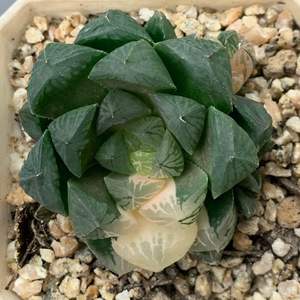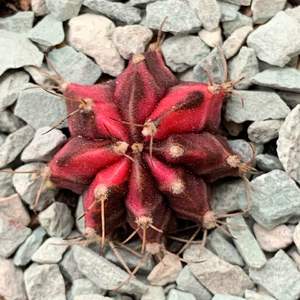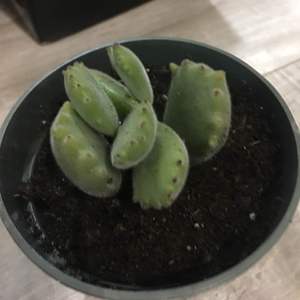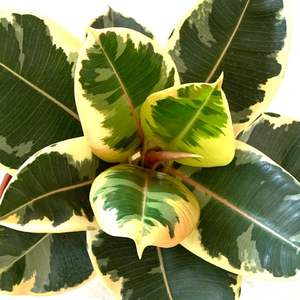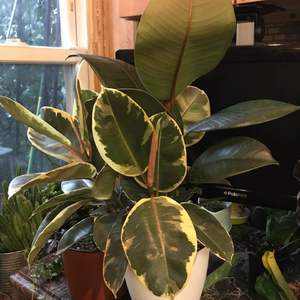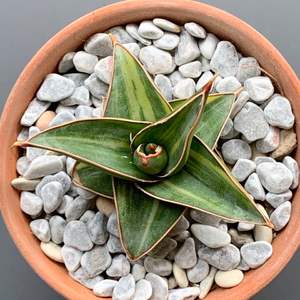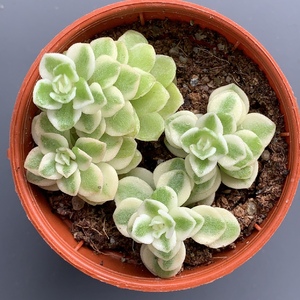文章
Miss Chen
2022年03月09日

A larger-than-life succulent, the century plant is a visually stunning agave species. It can grow up to ten feet wide and six feet tall with fleshy, arching leaves in grey-green or variegated colors. To protect itself, the leaves are tipped with sharp spines that ward off intruding pets or people. The sap of the plant is considered mildly toxic1.
Also known as the American aloe, the plant’s name is a misnomer. It was once believed that it took 100 years for this plant to bloom, but we now know that it blooms after two or three decades of storing up energy to send up a single stalk, topped with an inflorescence of small yellow blossoms. A monocarpic species, the flower display is the plant’s final act before dying.
Common Name Century plant, American aloe, maguey
Botanical Name Agave americana
Family Asparagaceae
Plant Type Succulent
Mature Size Three to six feet tall, six to ten feet wide
Sun Exposure Full
Soil Type Sandy, well-drained
Soil pH Acidic, neutral, alkaline
Bloom Time Summer (rarely blooms)
Flower Color Yellow
Hardiness Zones 8-11, USDA
Native Area Texas and Mexico
Toxicity Toxic to people, toxic to pets
Century Plant Care
Hands-off care and patience are required for growing a century plant. These large agaves must have well-draining soil and will benefit from intermittent watering, depending on climate conditions. As you wait a decade (and likely more) for the flower stalk to emerge, you can expect these plants to produce plenty of offshoots, which can be left to grow as part of a large colony or transplanted to new locations. Be vigilant towards the appearance of agave snout weevils, which can damage a plant beyond recovery.
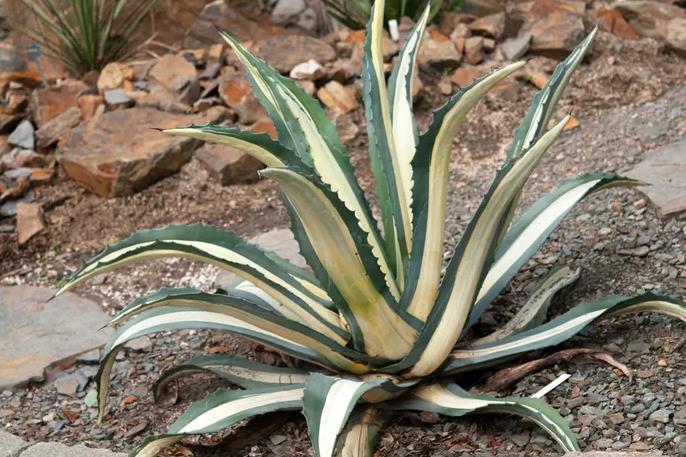
Light
Like other agave species, century plants do best with full sun, so plant them in a location that receives at least six to eight hours of sunlight each day. However, it is possible to grow these plants in light shade if your site doesn’t meet the requirements for full sun.
Soil
These plants do best in dry, sandy soil. They can tolerate a range of other soil types, including clay soil, but well-draining soil is an absolute requirement. Century plants in overly moist soil can develop root rot.
Water
The long and fleshy leaves of the century plant are designed to store water during times of drought, so don’t hover around these plants with a watering can. However, these plants appreciate regular watering during the spring and summer growing season. Water deeply but then allow the soil to dry thoroughly in between watering sessions; this might be an interval of a week to a month, depending on climate conditions.
Temperature and Humidity
The century plant is native to Mexico and Texas, providing an insight into the plant’s preferred temperature and humidity conditions. Warm temperatures with low humidity levels make for ideal climate conditions. Take note that the century plant is hardy to about 20 degrees Fahrenheit, but is likely to suffer damage from frost.
Fertilizer
It’s typically not necessary to fertilize a century plant. They do fine in sandy, nutrient-sparse soil. Like other agave species, these plants die after blooming so feeding with a fertilizer and accelerating the process only serves to shorten the plant’s lifecycle.
Types of Century Plants
‘Marginata’: Also sometimes known as a variegated century plant, this variety has cream-to-yellow margins along each side of the leaves, providing visual interest.
‘Mediopicta alba’: A slightly smaller cultivar variety, ‘Mediopicta alba’ features gray-green leaf margins with a single central stripe of creamy-white. It typically matures to a height of three to four feet, with a four- to six-foot spread.
‘Mediopicta aurea’: Similar to other mediopicta varieties of Agave americana, this cultivar matures to a smaller size at six feet tall and wide. It features variegated leaves with a bright yellow central stripe. It is generally also considered to fare better in light shade than some other agave varieties.
Propagating Century Plants
Like other agave species, century plants are most easily propagated from offsets. Also known as pups, these clones of the parent plant can easily be separated and planted independently. You won’t need many tools, because you can pull away the pups from the parent plant by hand in most cases. However, a small trowel can be useful and gloves will protect your hands from the spines of the parent plant. You will want to have a container or garden site ready with well-draining soil. Then, follow these steps to propagate:
After protecting your hands and arms, locate a pup at the base of the parent plant. In some cases, there can be a few pups growing close together. Use the trowel to gently loosen and separate the pups.
Grasp the pup at the base and wiggle it loose from the parent plant and soil. If necessary, use the trowel to separate the plant from the soil and roots attached to the parent plant. Leave a portion of the stem that connected to the offset to the parent, along with the pup’s root bundle. A bare base on the pup will be a challenging start to generating root growth.
Pups can be planted directly in the ground or in a container. In both instances, be sure to use well-draining soil.
How to Grow Century Plants From Seed
Growing a century plant from seed is fairly uncommon because the plant only flowers once in its lifetime only after several decades of growth. The much more common way to propagate a century plant is from offshoots, which it will regularly produce throughout its lifetime.
Potting and Repotting Century Plants
Century plants can be grown in pots, but keep in mind that these plants will mature to a very large size. Some gardeners choose to keep them in pots until the size of the plant (and its spiky leaves) makes it more practical to plant it in a permanent location in the ground.
If you choose to plant Agave americana in a container, choose a large pot and soil that offers excellent drainage. A combination of soil materials, such as an even mixture of compost, potting soil, and gravel or sand, is a good blend. You could also use a pre-mixed blend of succulent potting soil.
Fortunately, century plants are relatively slow-growing. You likely will only need to repot the plant every other year or so. When it's time to replant, wear protective gear like gloves, a long-sleeved shirt, and pants to protect your skin from sharp spines. Replace the potting soil with a fresh mixture and choose a larger pot that will allow for the continued growth of your century plant.
Overwintering
The century plant is not frost tolerant, so it must be brought indoors to survive winter weather outside of its growing zones. If you have cold but relatively dry winters, you can overwinter a mature agave plant by providing it with a measure of protection from the elements. Plant it in a location that is well-draining and sheltered from northern exposures. Another option is to situate the plant next to a large rock, which will radiate heat after the sun goes down. If overnight temperatures reach the lower limit of this plant’s tolerance, cover it with a cotton sheet for additional protection.
How to Get Century Plants to Bloom
The most challenging part of getting a century plant to bloom is waiting for it to happen. In most cases, it will take 20 to 30 years before the plant sends up a single branched stalk with blossoms, reaching 20 feet or more in height. Fertilized or rapidly maturing plants might blossom in as little as ten years, but this is the exception rather than the rule. These plants only bloom once in their lifecycle, after which the plant dies.
After the century plant blooms, the leaves will collapse and the parent plant will die. However, because these plants are prolific producers of pups, a colony of offshoots will continue to thrive in the location.
Common Problems With Century Plants
The century plant is a healthy, vigorous plant that grows well when provided with the right growing conditions. However, it can face challenges in overly-moist conditions and gardeners must be vigilant in warding off the plant’s primary nemesis: the agave snout weevil.
Wilting or discolored leaves
If the leaves of the century plant become squishy, wilted, or discolored, this is a likely indicator of the most common problem to affect century plants: root rot, which is caused by overly moist soil conditions due to excess rainfall or watering. If the plant is manageable in size to dig out of the ground, you can examine the roots and cut away any black, slimy parts. Treat the remaining roots with a copper fungicide. Replant it in a drier location or amend the soil to improve drainage, perhaps with pumice, gravel, or sand.
Weak or foul-smelling plant
Typically, the large-growing century plant is steady and won’t easily be budged from side-to-side. However, if you notice that your plant is tilting or leaning or if a foul smell is coming from the plant, these are indications of an agave snout weevil infestation. These species of weevil feasts on large agave species, like the century plant. They weaken the plant by burrowing into the leaves to lay eggs. Once hatched, the larvae feed on the plant’s tissue. Compounding the problem, bacteria enters the plant through the holes left by the weevil and the plant begins to decay, resulting in the foul smell. Once the visible signs of an agave snout weevil infestation are present, it’s often too late to save the plant. The best option is to protect century plants from weevils and other plants through a regular application of neem oil or other insecticide.

FAQ
Do century plants live for 100 years?
No. Despite the name, these plants have a lifespan of 25 to 30 years on average.
When does a century plant bloom?
A century plant will bloom once in its lifetime, usually between 25 and 30 years. Well-fertilized plants may bloom as soon as ten years, but most people avoid speeding up the blooming process, because the plant dies soon after blooming.
Are century plants easy to take care of?
These plants don't require regular maintenance and will grow with little hands-on care. It is important that they have well-draining soil and don’t receive too much moisture.
Also known as the American aloe, the plant’s name is a misnomer. It was once believed that it took 100 years for this plant to bloom, but we now know that it blooms after two or three decades of storing up energy to send up a single stalk, topped with an inflorescence of small yellow blossoms. A monocarpic species, the flower display is the plant’s final act before dying.
Common Name Century plant, American aloe, maguey
Botanical Name Agave americana
Family Asparagaceae
Plant Type Succulent
Mature Size Three to six feet tall, six to ten feet wide
Sun Exposure Full
Soil Type Sandy, well-drained
Soil pH Acidic, neutral, alkaline
Bloom Time Summer (rarely blooms)
Flower Color Yellow
Hardiness Zones 8-11, USDA
Native Area Texas and Mexico
Toxicity Toxic to people, toxic to pets
Century Plant Care
Hands-off care and patience are required for growing a century plant. These large agaves must have well-draining soil and will benefit from intermittent watering, depending on climate conditions. As you wait a decade (and likely more) for the flower stalk to emerge, you can expect these plants to produce plenty of offshoots, which can be left to grow as part of a large colony or transplanted to new locations. Be vigilant towards the appearance of agave snout weevils, which can damage a plant beyond recovery.

Light
Like other agave species, century plants do best with full sun, so plant them in a location that receives at least six to eight hours of sunlight each day. However, it is possible to grow these plants in light shade if your site doesn’t meet the requirements for full sun.
Soil
These plants do best in dry, sandy soil. They can tolerate a range of other soil types, including clay soil, but well-draining soil is an absolute requirement. Century plants in overly moist soil can develop root rot.
Water
The long and fleshy leaves of the century plant are designed to store water during times of drought, so don’t hover around these plants with a watering can. However, these plants appreciate regular watering during the spring and summer growing season. Water deeply but then allow the soil to dry thoroughly in between watering sessions; this might be an interval of a week to a month, depending on climate conditions.
Temperature and Humidity
The century plant is native to Mexico and Texas, providing an insight into the plant’s preferred temperature and humidity conditions. Warm temperatures with low humidity levels make for ideal climate conditions. Take note that the century plant is hardy to about 20 degrees Fahrenheit, but is likely to suffer damage from frost.
Fertilizer
It’s typically not necessary to fertilize a century plant. They do fine in sandy, nutrient-sparse soil. Like other agave species, these plants die after blooming so feeding with a fertilizer and accelerating the process only serves to shorten the plant’s lifecycle.
Types of Century Plants
‘Marginata’: Also sometimes known as a variegated century plant, this variety has cream-to-yellow margins along each side of the leaves, providing visual interest.
‘Mediopicta alba’: A slightly smaller cultivar variety, ‘Mediopicta alba’ features gray-green leaf margins with a single central stripe of creamy-white. It typically matures to a height of three to four feet, with a four- to six-foot spread.
‘Mediopicta aurea’: Similar to other mediopicta varieties of Agave americana, this cultivar matures to a smaller size at six feet tall and wide. It features variegated leaves with a bright yellow central stripe. It is generally also considered to fare better in light shade than some other agave varieties.
Propagating Century Plants
Like other agave species, century plants are most easily propagated from offsets. Also known as pups, these clones of the parent plant can easily be separated and planted independently. You won’t need many tools, because you can pull away the pups from the parent plant by hand in most cases. However, a small trowel can be useful and gloves will protect your hands from the spines of the parent plant. You will want to have a container or garden site ready with well-draining soil. Then, follow these steps to propagate:
After protecting your hands and arms, locate a pup at the base of the parent plant. In some cases, there can be a few pups growing close together. Use the trowel to gently loosen and separate the pups.
Grasp the pup at the base and wiggle it loose from the parent plant and soil. If necessary, use the trowel to separate the plant from the soil and roots attached to the parent plant. Leave a portion of the stem that connected to the offset to the parent, along with the pup’s root bundle. A bare base on the pup will be a challenging start to generating root growth.
Pups can be planted directly in the ground or in a container. In both instances, be sure to use well-draining soil.
How to Grow Century Plants From Seed
Growing a century plant from seed is fairly uncommon because the plant only flowers once in its lifetime only after several decades of growth. The much more common way to propagate a century plant is from offshoots, which it will regularly produce throughout its lifetime.
Potting and Repotting Century Plants
Century plants can be grown in pots, but keep in mind that these plants will mature to a very large size. Some gardeners choose to keep them in pots until the size of the plant (and its spiky leaves) makes it more practical to plant it in a permanent location in the ground.
If you choose to plant Agave americana in a container, choose a large pot and soil that offers excellent drainage. A combination of soil materials, such as an even mixture of compost, potting soil, and gravel or sand, is a good blend. You could also use a pre-mixed blend of succulent potting soil.
Fortunately, century plants are relatively slow-growing. You likely will only need to repot the plant every other year or so. When it's time to replant, wear protective gear like gloves, a long-sleeved shirt, and pants to protect your skin from sharp spines. Replace the potting soil with a fresh mixture and choose a larger pot that will allow for the continued growth of your century plant.
Overwintering
The century plant is not frost tolerant, so it must be brought indoors to survive winter weather outside of its growing zones. If you have cold but relatively dry winters, you can overwinter a mature agave plant by providing it with a measure of protection from the elements. Plant it in a location that is well-draining and sheltered from northern exposures. Another option is to situate the plant next to a large rock, which will radiate heat after the sun goes down. If overnight temperatures reach the lower limit of this plant’s tolerance, cover it with a cotton sheet for additional protection.
How to Get Century Plants to Bloom
The most challenging part of getting a century plant to bloom is waiting for it to happen. In most cases, it will take 20 to 30 years before the plant sends up a single branched stalk with blossoms, reaching 20 feet or more in height. Fertilized or rapidly maturing plants might blossom in as little as ten years, but this is the exception rather than the rule. These plants only bloom once in their lifecycle, after which the plant dies.
After the century plant blooms, the leaves will collapse and the parent plant will die. However, because these plants are prolific producers of pups, a colony of offshoots will continue to thrive in the location.
Common Problems With Century Plants
The century plant is a healthy, vigorous plant that grows well when provided with the right growing conditions. However, it can face challenges in overly-moist conditions and gardeners must be vigilant in warding off the plant’s primary nemesis: the agave snout weevil.
Wilting or discolored leaves
If the leaves of the century plant become squishy, wilted, or discolored, this is a likely indicator of the most common problem to affect century plants: root rot, which is caused by overly moist soil conditions due to excess rainfall or watering. If the plant is manageable in size to dig out of the ground, you can examine the roots and cut away any black, slimy parts. Treat the remaining roots with a copper fungicide. Replant it in a drier location or amend the soil to improve drainage, perhaps with pumice, gravel, or sand.
Weak or foul-smelling plant
Typically, the large-growing century plant is steady and won’t easily be budged from side-to-side. However, if you notice that your plant is tilting or leaning or if a foul smell is coming from the plant, these are indications of an agave snout weevil infestation. These species of weevil feasts on large agave species, like the century plant. They weaken the plant by burrowing into the leaves to lay eggs. Once hatched, the larvae feed on the plant’s tissue. Compounding the problem, bacteria enters the plant through the holes left by the weevil and the plant begins to decay, resulting in the foul smell. Once the visible signs of an agave snout weevil infestation are present, it’s often too late to save the plant. The best option is to protect century plants from weevils and other plants through a regular application of neem oil or other insecticide.

FAQ
Do century plants live for 100 years?
No. Despite the name, these plants have a lifespan of 25 to 30 years on average.
When does a century plant bloom?
A century plant will bloom once in its lifetime, usually between 25 and 30 years. Well-fertilized plants may bloom as soon as ten years, but most people avoid speeding up the blooming process, because the plant dies soon after blooming.
Are century plants easy to take care of?
These plants don't require regular maintenance and will grow with little hands-on care. It is important that they have well-draining soil and don’t receive too much moisture.
0
0
成长记
kensong
2019年05月27日

I now added "❤️ Variegated Licuala Grandis (Ruffled Fan Palm)" in my "garden"
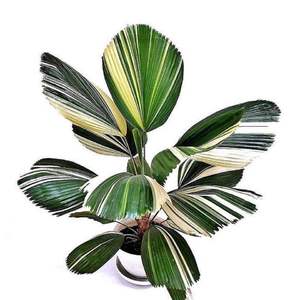

4
0
成长记
Plantlin
2019年05月17日

This year I planted a different kind of zebrina on the same spot. Tradescantia zebrina var. zebrina. It was variegated, but its reverting.
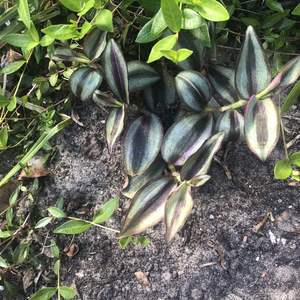

0
0
成长记
jichi
2019年03月24日

I now added "多肉·熊童子白锦 Cotyledon ladismithiensis variegated" in my "garden"
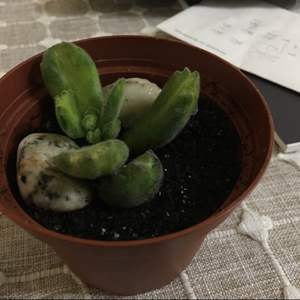

0
0
成长记
Rmaslikhov
2019年01月27日

I now added "PEPEROMIA OBTUSIFOLIA (Variegated) - Baby Rubber Plant" in my "garden"
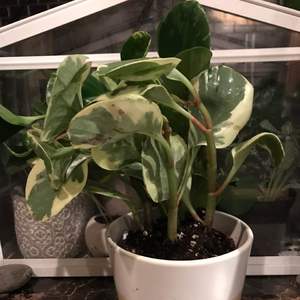

0
0
求助
Lucky Coyote
2018年12月17日

My neighbor brought this to me after another person had moved, she thinks it's variegated Jasmine, but I'm not sure. It's 2 ft tall
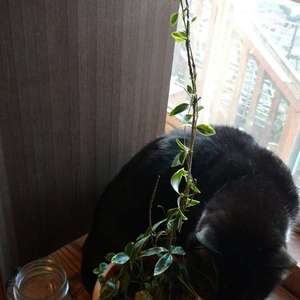
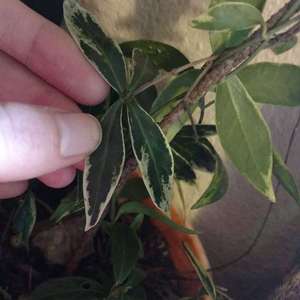


0
0
Lucky Coyote:@mailipod5 my neighbor moved and another brought the plant over. What else could it possibly mean?
mailipod5:what' mean 'had moved'?


